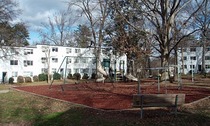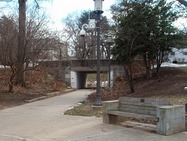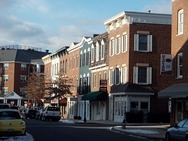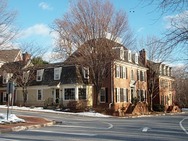Two (very different) planned towns in Maryland

Greenbelt’s central business area, built in rounded International Style.
Passing through the D.C. metro area after New Year’s, we decided to visit two classic planned communities in the Maryland suburbs: Greenbelt and Kentlands.
Both were planned and built from the ground up and both contain around 2,000 households. Otherwise, they could not be more different.
One was entirely created by the federal government, the other by private developers. One was born in the depth of the Great Depression, the other during boom years of the American economy. One has a current average home sale price of around $160,000, the other $800,000. One is exclusively modernist in style, the other highly traditional both in planning and architecture.
Anyone who seeks to pigeonhole planning into one ideological camp or the other may want to take a look at these two very different models. While there are certainly arguments to be made either for or against each of these, it seems pretty clear to me that they fit into different economic niches and lifestyle preferences. The overall metro area is that much richer for having both of them.
Greenbelt, Maryland
Our first stop was in Greenbelt, Maryland, the largest of the three garden-city inspired towns built during Franklin Roosevelt’s New Deal. Agricultural economist Rexford Guy Tugwell convinced the president that settling a displaced rural population into new towns outside of major cities was more preferable to a back-to-the-land approach, and the U.S. Redevelopment Administration was created for him. While Tugwell originally conceived of 3,000 distinct mostly self-sufficient communities around the country, congressional wrangling, legal battles, and a ticking clock whittled this down to just three. Greenbelt, with the help of avid personal support from Eleanor Roosevelt, was the most complete.

One of many playgrounds tucked between apartments and townhomes.
The town is designed in a crescent shape around a central community and business area, which is within walking distance of all dwellings. Many of the businesses are still functioning as community co-ops, although the federal government has long since left the picture. On the cold Saturday we visited, the New Deal Cafe and the Co-op grocery store seemed to be doing brisk business. The Community Center, originally the town school, contains a whole floor of artist studios, gathering places for seniors, an adjacent library, a gymnasium, and a small museum. We got the impression that this still serves as the communal heart of the town.
Pedestrian underpasses are used to connect this central area with the trail systems weaving throughout the superblocks of surrounding residences. The planners were certainly intent on strictly separating cars from people. Although there is an obvious symmetry and geometric orderliness to the plan, the abundant use of green space and scattered trees still gives it an informal feel. True to the name, natural amenities were an integral part of the plan.

The Community Center feels like an art deco college campus.
Although much of the green belt that originally surrounded the town has been sliced up with major highways or sold off for development, the amount of unprogrammed green space is still unusually high for the area.
The nuclear family was the essential building block of the design, not to mention the overall experiment in New Deal social engineering. Almost all of the original residents were young families (this was clearly intentional, since only 900 of 5,000 applicants were admitted). Small playgrounds are located all over, but one gets the sense that the entire town is built as a comprehensive playground for children. The size of the homes was allotted according to family size; apartments for married couples with infants that could be traded up for townhouses as the family grew.

Cars and pedestrians, never the twain shall meet.
Today, the community gives every impression of being incredibly multi-generational. The same goes for racial diversity. Blacks were, sadly, excluded from the first government settlement, but now comprise around 40% of the population. Given the affordable housing options, there is also a reasonably broad range of income levels in the town. Large signs now welcome visitors into the “inclusive community” of Greenbelt.
According to historian Peter Hall, this globally unique experiment in federal planning collapsed under the weight of an ensuing public outcry against socialism. Sure enough, some of the inspirational engravings lining the community center do give off a downright Soviet vibe, even if they are depicting the U.S. Constitution. According to Hall, “There is a slight irony in that it all happened in the United States, which is almost the last country anyone would expect it to happen. And there, it is hardly surprising that it failed.”
Although the initial experiment did undoubtedly fail and many of the design decisions were deliberately anti-urban, in many ways the contemporary Greenbelt community seems to have matured into a more complex, if less ideologically pure, expression of some of its original ideals.
Kentlands, Maryland

Building to the sidewalk encloses the street and caters to the pedestrian.
The Kentlands neighborhood is well known among planners and architects as the first true example of New Urbanism in the United States. The entire development follows a colonial style of architecture, reminiscent of Georgetown or Old Town Alexandria, although that, in and of itself, is hardly unusual for contemporary residential development. What set Kentlands apart from the other subdivisions surrounding it is the incorporation of traditional town elements such as a connected street grid, narrow streets, minimal setback and yard sizes, ample sidewalks, a mix of uses (at least in some cases), and scale to encourage walking. Anyone who’s read more than two posts on this blog should be pretty familiar with these concepts.
I recall one time hearing Andres Duany, whose architecture firm was behind Kentlands, explain that a neighborhoods need to stew in its juices for a while like a good soup before it reaches its fullest design expression.

A colonial style is clearly evident throughout the neighborhood.
Kentlands has had over 20 years to grow into itself and the maturation shows. Even in the winter, well-placed trees create a perfect natural accent to the fairly dense residential areas. Residents over time start to settle in and lend a place their own character while still staying within the initially conceived order. We were surprised to stumble upon both a Jewish Synagogue and a Mormon church tucked between the homes.
I’m aware of criticisms lodged against places like Kentlands. In fact, being immersed in academia for the time being, I’m very aware of these criticisms. Kentlands was built on a greenfield on the fringes of a metropolitan area with little access to transit. Although the variety of housing options is quite diverse - this is something the neighborhood does well - moderate to lower-income households are still mostly priced out. Marxist geographer David Harvey may have been a little hyperbolic when he declared that it “builds an image of community and a rhetoric of place-based civic pride and consciousness for those who do not need it, while abandoning those that do to their ‘underclass’ fate.”

A vertical mix of uses is challenging to pull off.
When you consider the context, it seems forgivable that the physical form of one development is unable to achieve large-scale social upheaval or the unraveling of regional agglomeration economies. The commercial center of Kentlands actually folds into a conventional regional shopping plaza with giant parking lots lurking behind, which speaks to the current economic realities that still needed to be considered to make it viable in the marketplace. The proper comparison to Kentlands is what would have been there otherwise, not a theoretical utopia or even New Urbanist ideals themselves. Any real world positive and lasting change has to be incremental.
It’s also not hard to imagine some of the more trenchant criticisms dissipating in time. The Shady Grove Metro station is only a 4 mile bus ride away. A little tweak in the price points of automobile travel may facilitate a more transit-oriented adaptation in the future. And housing stock typically becomes more affordable in time, which may take the edge off of claims to exclusivity. In a fast-changing world it can be tough to remember that well-built places will last for a century or more. They can only truly be judged in view of the entirety of their lifespans.
Cross-posted at Discovering Urbanism.
